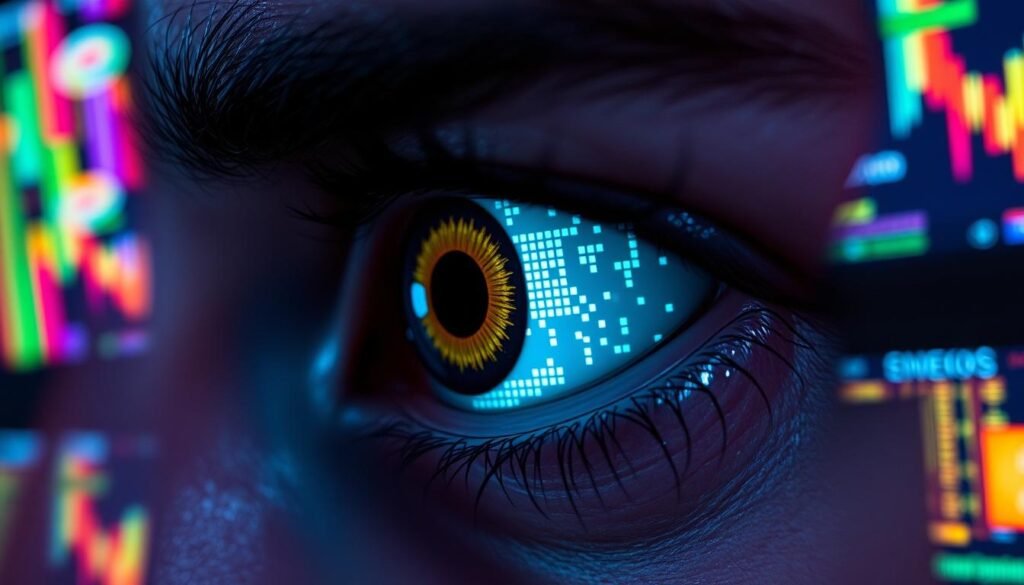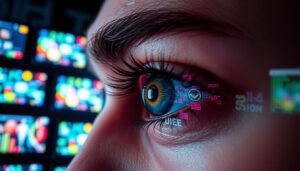Imagine waking up every morning with clear vision. No more struggles with poor eyesight or vision problems. Many vision impairments can be prevented or treated. This can reduce the risk of blurry vision and eye disorders.
As we age, our vision changes are common. But, we don’t have to accept them as inevitable. About 33% of people with diabetes aged 40 or older have diabetic retinopathy. This shows the importance of taking care of our eye health.Poor Eyesight
Understanding the causes and impact of poor eyesight is key. Over 150 million people in the U.S. have a refractive error that can be corrected. There are many effective solutions out there. The right approach depends on your individual needs.
Whether it’s medical solutions, natural methods, or lifestyle changes, there’s something for everyone. The goal is to find what works best for you. This will help you overcome poor eyesight and support your eye health.
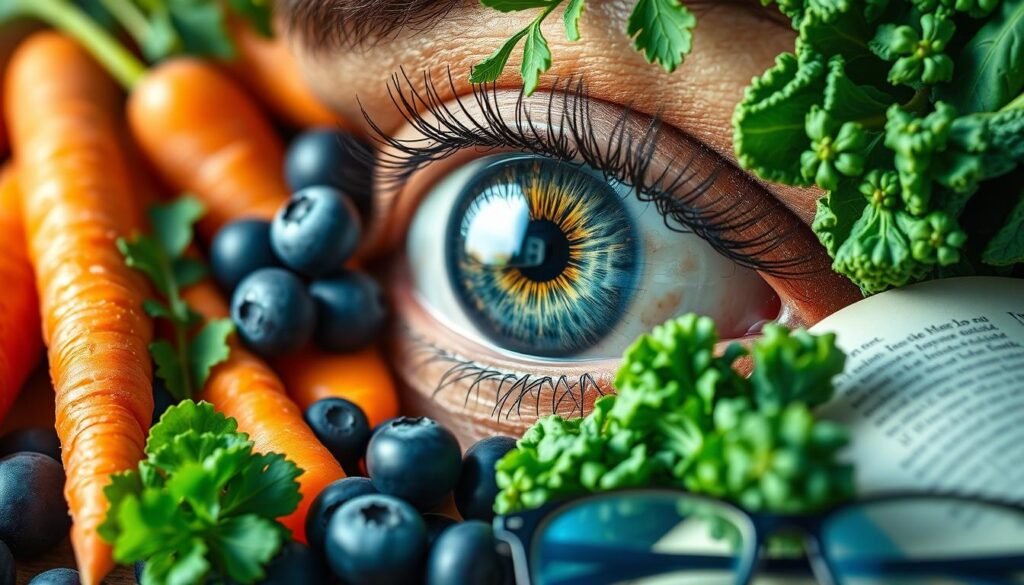
Key Takeaways
- Many vision impairments can be prevented or treated with the right approach
- Poor eyesight and vision problems can be caused by a range of factors, including age-related vision changes and eye disorders
- Proactive eye health management is crucial for reducing the risk of blurry vision and eye disorders
- Effective solutions for overcoming poor eyesight include medical solutions, natural methods, and lifestyle changes
- Understanding the causes and impact of poor eyesight is the first step towards finding a solution
- Regular eye exams and a healthy lifestyle can help support overall eye health
- With the right approach, you can take control of your vision health and reduce the risk of vision problems
Understanding Poor Eyesight and Its Impact
Poor eyesight, including impaired vision and low vision, affects millions globally. Visual impairment can stem from many causes, like refractive errors or age-related diseases. Weak eyesight makes daily tasks hard and raises accident risks.Poor Eyesight
About 75% of U.S. adults need vision correction. Blurred vision is common, often from refractive errors. Eye diseases like macular degeneration grow more common with age.
Common Causes of Vision Problems
Vision issues come from many sources, including:
- Refractive errors, such as nearsightedness and farsightedness
- Age-related macular degeneration
- Diabetic retinopathy
- Glaucoma
- Cataracts
Signs and Symptoms of Deteriorating Vision
Signs of vision decline include:
- Blurred vision
- Double vision
- Sensitivity to light
- Floaters
How Poor Eyesight Affects Daily Life
Poor eyesight makes daily tasks hard and raises accident risks. Regular eye exams can lower disease risk.Poor Eyesight
| Eye Disease | Prevalence | Risk Factors |
|---|---|---|
| Age-related macular degeneration | Approximately 10 million Americans | Age, diabetes, high blood pressure |
| Glaucoma | Approximately 3 million Americans | Age, family history, African American descent |
| Cataracts | Approximately 24 million Americans over 40 | Age, diabetes, smoking, excessive sunlight exposure |
Medical Solutions for Vision Correction
Regular eye care is key to catching and treating vision issues early. Many vision problems, like astigmatism, can be fixed if found early. A full eye exam can spot potential problems, and treatments like glasses, contacts, or surgery can fix vision problems.
Some common fixes for vision issues include LASIK surgery, which many patients find very satisfying. But, it’s important to think about the risks, like eye strain and dry eyes. Other choices, like orthokeratology lenses and atropine drops, can also help, especially in kids.
It’s also vital to keep up with good eye care habits. This means regular check-ups and a healthy lifestyle. By being proactive about our vision, we can lower the chance of vision issues and keep our eyes healthy for a long time.
The Role of Corrective Lenses in Treating Poor Eyesight
Corrective lenses are key in fixing vision problems, helping nearly 70% of people with vision issues. They correct errors like farsightedness and nearsightedness by focusing light right on the retina. This makes vision clearer. Optometrists use special curves in these lenses to improve vision care.
Choosing between prescription glasses and contact lenses depends on personal preference. Contact lenses give better side vision, while prescription glasses are more traditional. New lens technologies make them more comfortable and effective. There are many types, like single vision, multifocal, trifocal, and progressive lenses.
Prescription Glasses vs Contact Lenses
- Prescription glasses: suitable for individuals who prefer a non-invasive approach to vision correction
- Contact lenses: ideal for those who want better peripheral vision and a more natural look
Latest Innovations in Lens Technology
The market for corrective eyewear is expected to hit about $200 billion by 2025. This growth is thanks to new lens tech and more people needing vision care. Corrective lenses help people see better and live better lives.
| Type of Corrective Lens | Description |
|---|---|
| Convex lenses | Used to correct farsightedness (hyperopia) |
| Concave lenses | Used to correct nearsightedness (myopia) |
Surgical Options for Vision Improvement
For those looking to improve their vision, surgery is an option. Eye surgery can fix issues like cataracts and age-related macular degeneration. It’s important to talk to an eye doctor to see if surgery is right for you.
Popular surgical options include LASIK, PRK, and intraocular lens implants. These can help with nearsightedness, farsightedness, and astigmatism. Always discuss the pros and cons with an eye specialist to find the best treatment.
Before eye surgery, you’ll need a stable vision prescription and a full eye check. The surgery is usually quick, lasting up to 30 minutes. Most people can go home within an hour and get back to normal in a few days.
While surgical options work well, it’s important to know the risks. LASIK might cause dry eyes or vision problems, but these usually go away in weeks or months. Serious problems are rare, and most people see big improvements after surgery.
| Surgical Option | Procedure | Recovery Time |
|---|---|---|
| LASIK | Corrects nearsightedness, farsightedness, and astigmatism | 1-2 days |
| PRK | Corrects nearsightedness, farsightedness, and astigmatism | 3-4 days |
| Intraocular Lens Implantation | Replaces natural lens with artificial lens | 1-2 weeks |
Natural Methods to Support Eye Health
Keeping your eyes healthy is key for clear vision and avoiding eye diseases. Eating a balanced diet full of vitamins and minerals is very important. A good diet and healthy lifestyle can lower the chance of eye problems.
Eating foods rich in omega-3 fatty acids, like salmon and tuna, can help with dry eye syndrome. Leafy greens, such as spinach and kale, are full of lutein for eye health. Citrus fruits are also good because they have lots of vitamin C, which can prevent cataracts.
Essential Vitamins and Minerals
Some vitamins and minerals are vital for your eyes. Vitamin A helps prevent night blindness and dry eyes. Vitamin C and vitamin E are antioxidants that fight age-related macular degeneration. Zinc is also important for healthy vision.
Dietary Recommendations
Eating lots of fruits, vegetables, and whole grains is good for your eyes. Foods with antioxidants, like berries and leafy greens, can lower eye disease risk. Eating at least 2 cups of leafy greens a week can help keep your eyes healthy.
Lifestyle Modifications
Changing your lifestyle can also help your eyes. Regular exercise and not smoking are good for your vision. Wearing sunglasses with 100% UV protection can also help prevent cataracts. By eating well and making healthy lifestyle choices, you can support your eye health.
Digital Eye Strain and Modern Vision Challenges
Digital devices are everywhere, and digital eye strain is a big problem. About 75% of adults face eye strain from too much screen time. This can lead to headaches and blurry vision. Computer vision syndrome is another term for eye discomfort and vision issues from too much computer use.
To fight digital eye strain, taking breaks is key. Try the 20-20-20 rule: every 20 minutes, look 20 feet away for 20 seconds. Adjusting your screen and drinking water can also help. Here are some tips to avoid digital eye strain:
- Follow the 20-20-20 rule
- Take breaks from screens
- Adjust your screen settings to reduce glare
- Drink plenty of water
Knowing the risks of digital eye strain and taking steps to prevent it is crucial. This can lower the chance of computer vision syndrome and other eye issues. Regular eye exams are also vital to catch problems early. So, taking care of your eyes in today’s digital world is essential.
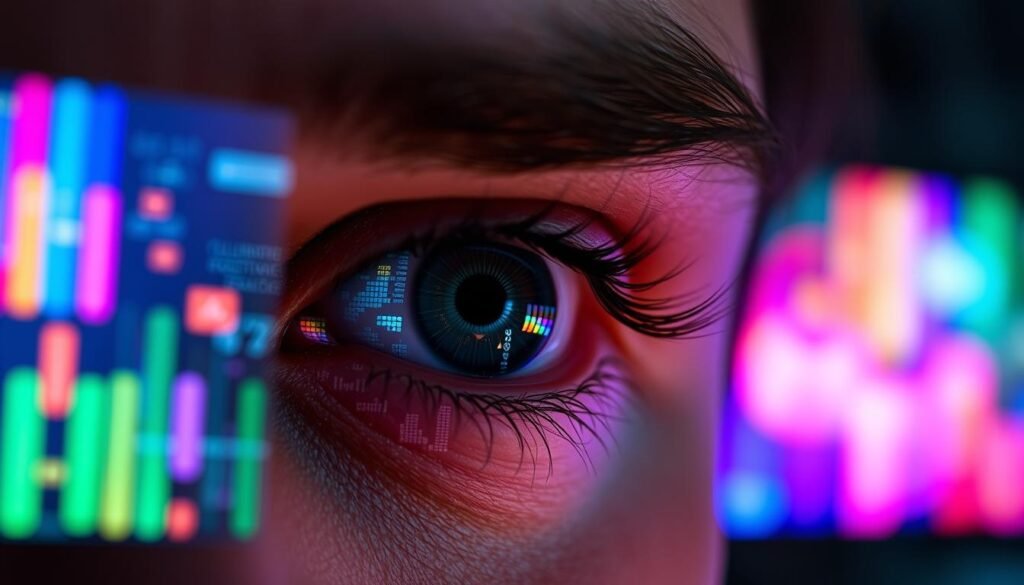
Exercise and Activities for Better Eye Health
Regular exercise is key for good eye health. It can cut down the risk of cataracts and macular degeneration. For instance, running or walking for 30 minutes a day can lower cataract risk. Also, exercising three or more times a week can reduce the risk of wet macular degeneration.
Adding relaxation techniques to your day can ease eye strain. The 20-20-20 rule is simple yet effective: every 20 minutes, look at something 20 feet away for 20 seconds. This can lessen eye strain and prevent dryness. Vision training exercises, like pencil push-ups and tracking, can boost visual skills and reduce eye strain.
- Wearing protective eyewear when engaging in sports or activities that could potentially harm your eyes
- Following the 20-20-20 rule when working on computers or digital devices
- Getting regular comprehensive eye exams to diagnose and prevent eye problems
By adding these habits and exercises to your daily routine, you can keep your eye health in check. Always remember to prioritize your eye health and take regular breaks to rest your eyes.
Regular Eye Care and Prevention Strategies
Regular eye care is key to keeping your vision healthy. Prevention strategies like wearing protective eyewear and living a healthy lifestyle can help. The American Academy of Ophthalmology says getting comprehensive dilated eye exams is vital. This helps catch diseases like glaucoma and age-related macular degeneration early.
Some important prevention strategies include wearing sunglasses that block 99% of UVA and UVB radiation. Also, following the 20-20-20 rule can help reduce eye strain from computer use. Eating a diet full of fruits, vegetables, especially dark leafy greens and omega-3 fatty acids, is also good for your eye health.
Also, regular eye care means getting eye exams on time. The US Preventive Services Task Force suggests kids should have an eye exam between ages 3 and 5. Adults over 60 should get eye exams every 1 to 2 years. By focusing on regular eye care and prevention strategies, you can lower the risk of vision problems. This helps keep your vision healthy for many years.
| Age Group | Recommended Eye Exam Frequency |
|---|---|
| Children (3-5 years) | At least once |
| Adults (18-60 years) | Every 2-3 years |
| Adults (61 years and older) | Every 1-2 years |
Alternative Therapies and Complementary Treatments
Many people are now using alternative therapies and complementary treatments for their eye health. These methods can work alongside traditional medicine to offer extra benefits. For example, acupuncture is known to reduce stress and improve overall health, which can help the eyes.
Complementary treatments, like herbal remedies, are also gaining popularity for vision health. Herbs like bilberry and lutein might help the eyes. Mind-body practices, such as meditation and yoga, can also reduce stress and support eye health.
Some common alternative therapies and complementary treatments for eye health include:
- Acupuncture: a traditional Chinese medicine technique that involves inserting small needles into specific points on the body to stimulate healing and balance
- Herbal remedies: such as bilberry, lutein, and omega-3 fatty acids, which may help to support eye health
- Mind-body approaches: like meditation and yoga, which can help to reduce stress and promote relaxation
While more research is needed, many people find these methods helpful. By adding them to their routine, individuals can actively support their eye health and overall well-being.
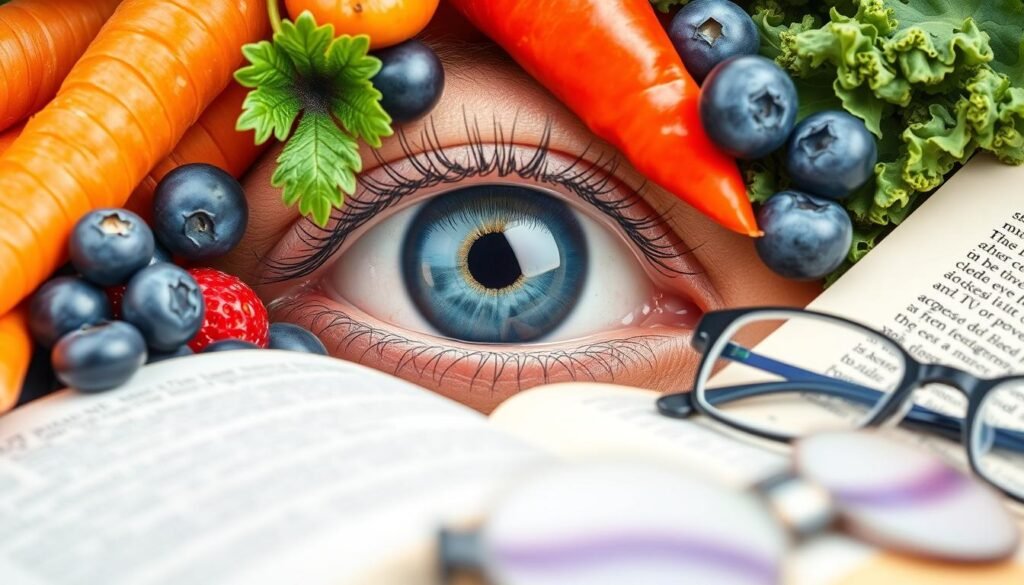
When to Seek Professional Help
It’s important to know when to get professional help for your eyes. If your vision or eye health changes, see an eye care professional right away. Regular eye exams and preventive steps can lower the risk of vision problems.
Signs you might need professional help include blurred vision, double vision, eye pain, or light sensitivity. If you notice any of these, book an appointment with an eye care professional. They can find out what’s wrong and treat it.
There are also steps you can take to keep your vision healthy. Eating well, staying active, and not smoking can help. By taking these steps and getting professional help when needed, you can protect your vision and keep your eyes healthy.
| Common Causes of Low Vision | Description |
|---|---|
| Age-related macular degeneration | A condition that affects the macula, the part of the eye responsible for central vision |
| Diabetic retinopathy | A condition that damages the blood vessels in the retina, leading to vision loss |
| Glaucoma | A group of eye conditions that damage the optic nerve, leading to vision loss |
Latest Technologies and Innovations in Vision Care
The field of vision care is changing fast. Latest technologies and innovations are changing how we care for our eyes. New smart devices and treatments are making a big difference.
AI algorithms are now predicting eye problems like diabetic retinopathy and age-related macular degeneration. Smart devices like virtual reality and artificial intelligence are also helping. They offer new hope for people with vision problems.
Home Optical Coherence Tomography (OCT) machines are being developed. They are going through FDA approval. Telehealth and remote monitoring are also improving patient care.
With these latest technologies and innovations, eye health is set to improve a lot. We can expect better outcomes for many people.
Emerging Treatment Options
New treatments like gene therapy and stem cell therapy are coming. They offer hope for vision restoration. These innovations could change vision care forever. They could greatly improve the lives of millions.
Conclusion: Taking Control of Your Vision Health
It’s crucial to take charge of your vision health to keep your eyes clear and healthy. Understanding the causes of vision problems helps you tackle them. You can use medical treatments, glasses, or natural methods to improve your vision.
Adding important vitamins and minerals to your diet is a good start. Also, adopting healthy habits for your eyes is key. Stay updated with the latest in eye care and seek expert advice. This way, you can protect your vision and see the world clearly for many years.
FAQ
What are the common causes of vision problems?
Vision problems can come from many sources. These include refractive errors, age-related macular degeneration, and diabetic retinopathy.
What are the signs and symptoms of deteriorating vision?
Signs of bad vision include blurred vision, double vision, and light sensitivity.
How does poor eyesight affect daily life?
Bad eyesight makes daily tasks hard. It also raises the chance of accidents.
What are the medical solutions for vision correction?
Doctors can find and treat eye issues. Glasses, contacts, or surgery can fix vision problems.
What are the differences between prescription glasses and contact lenses?
Glasses and contacts both have good points. The best choice depends on what you need and like.
What are the surgical options for vision improvement?
Surgery can fix cataracts, glaucoma, and macular degeneration. But, talk to a doctor about the risks and benefits.
What are the natural methods to support eye health?
Good vitamins, a healthy diet, and exercise help eyes. Also, protect your eyes from the sun.
How can I reduce digital eye strain?
Follow the 20-20-20 rule, take breaks, and adjust your screen settings to lessen eye strain.
What exercises and activities can improve eye health?
Try eye relaxation, vision training, and wear protective eyewear. These can help your eyes stay healthy.
How often should I get my eyes examined?
Get your eyes checked often. It helps catch diseases early and keeps your vision healthy.
Are there any alternative therapies or complementary treatments for eye health?
Acupuncture, herbal remedies, and meditation might help your eyes. But, more research is needed.
When should I seek professional help for vision problems?
See an eye doctor if your vision or eye health changes. They can help with diagnosis and treatment.
What are the latest technologies and innovations in vision care?
New tech includes smart devices, virtual reality, and gene therapy. These might offer new ways to fix vision problems.
Source Links
- https://weillcornell.org/news/how-to-improve-vision-and-maintain-eye-health
- https://www.healthline.com/health/how-to-improve-eyesight
- https://www.health.ny.gov/diseases/conditions/vision_and_eye_health/types_of_vision_problems.htm
- https://www.allaboutvision.com/conditions/bad-eyesight-causes/
- https://www.mayoclinic.org/diseases-conditions/nearsightedness/diagnosis-treatment/drc-20375561
- https://www.aoa.org/healthy-eyes/caring-for-your-eyes/low-vision-and-vision-rehab
- https://www.mayoclinic.org/tests-procedures/lasik-eye-surgery/about/pac-20384774
- https://courses.lumenlearning.com/suny-physics/chapter/26-2-vision-correction/
- https://www.texasoptical.net/blog/corrective-lenses/
- https://my.clevelandclinic.org/health/treatments/8608-vision-correction-surgery
- https://www.mayoclinic.org/tests-procedures/lasik-eye-surgery/in-depth/lasik-surgery/art-20045751
- https://floridaeye.org/eye-health/natural-remedies-to-reverse-vision-loss-fact-or-fiction/
- https://kraffeye.com/blog/10-foods-to-improve-eyesight
- https://primeraeyecare.com/what-causes-bad-eyesight/
- https://www.hopkinsmedicine.org/health/wellness-and-prevention/how-to-know-if-your-child-needs-glasses
- https://eyespecialistsofla.com/can-exercise-improve-my-eyesight/
- https://kraffeye.com/blog/8-easy-eye-exercises-to-improve-vision-techniques-and-tips
- https://www.webmd.com/eye-health/eye-exercises
- https://www.cdc.gov/vision-health/prevention/index.html
- https://www.cdc.gov/vision-health/prevention/taking-care-of-your-eyes.html
- https://www.webmd.com/eye-health/good-eyesight
- https://pmc.ncbi.nlm.nih.gov/articles/PMC7784325/
- https://pmc.ncbi.nlm.nih.gov/articles/PMC3155887/
- https://www.guidedogs.org.uk/getting-support/information-and-advice/eye-health/is-bad-eyesight-genetic/
- https://www.bannerhealth.com/healthcareblog/better-me/these-4-tips-can-help-you-cope-with-low-vision
- https://healthtechmagazine.net/article/2022/11/innovations-eye-care-how-technology-transforming-ophthalmology-perfcon
- https://lighthouseguild.org/fantastic-new-tech-for-people-with-low-vision-or-blindness/
- https://modernod.com/articles/2021-sept/latest-innovations-and-future-directions-in-optometry
- https://www.ncbi.nlm.nih.gov/books/NBK402367/
Click here to learn more about this topic in a related article.
